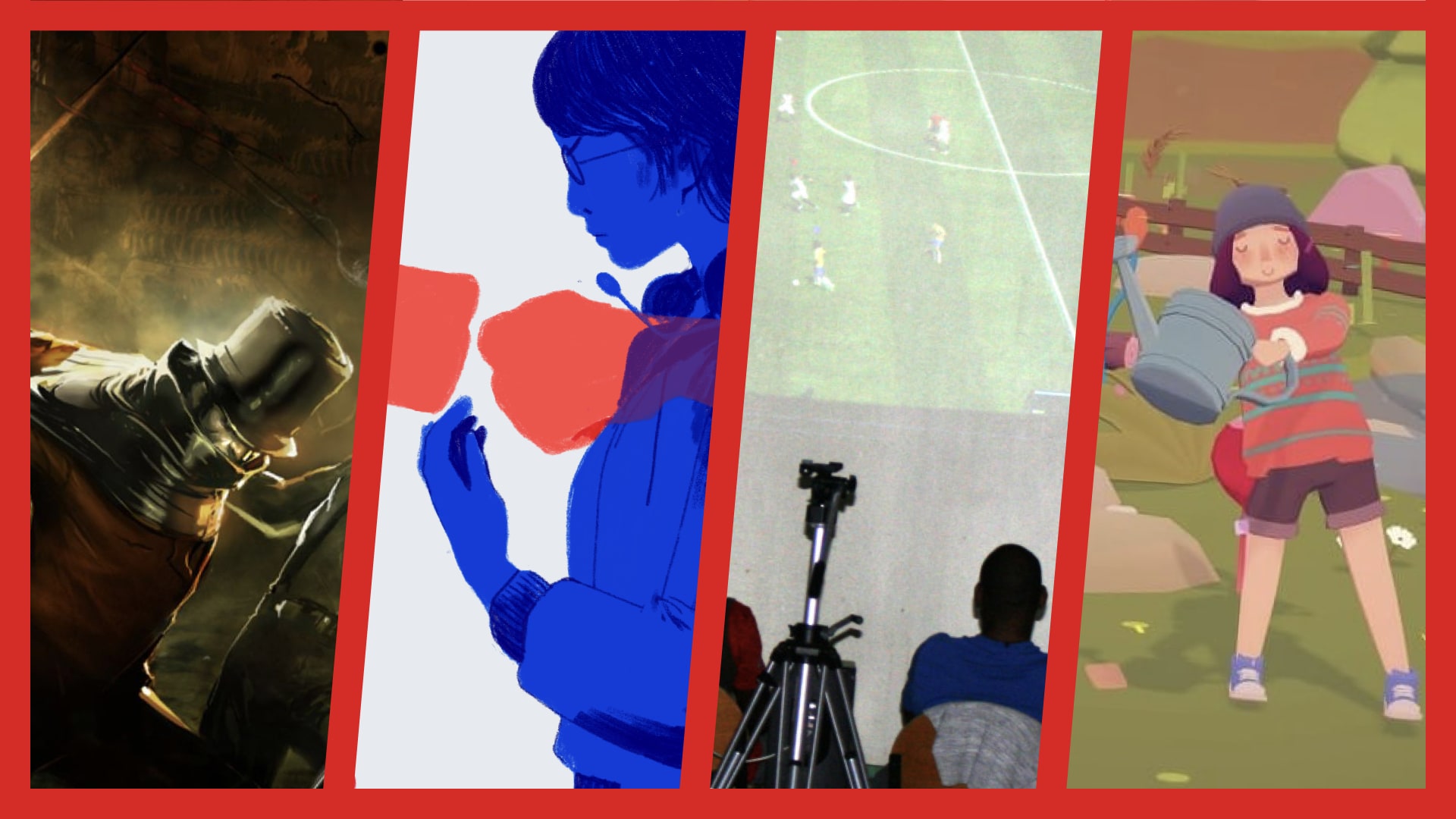Des liens de fond autour du jeu vidéo, loin de l’actualité quotidienne trépidante. Articles, vidéos, émissions, et autres formats longs.
À lire en français
Le jeu vidéo en prison – Ellen Replay / CanardPC ?
En cette pluvieuse après-midi du 15 juin, le lendemain du match d’ouverture de la Coupe du monde qui opposait la Russie à l’Arabie saoudite, une poignée de détenus de la maison centrale de Saint-Maur se disputait la première place d’une compétition organisée par un surveillant pénitentiaire.
« Les jeux vidéo sont des distributeurs de petites transes domestiques » – Ferdinand Cazalis et Nathalia Kloos / Jef Klak ?
S’il est naturel de se demander comment, de quoi, et par qui ils sont conçus, on peut aussi chercher à savoir ce que fait un joueur devant l’écran, et quelles puissances il y trouve. C’est la démarche de Mathieu Triclot, auteur de Philosophie des jeux vidéo, paru en 2011 chez Zones. En investiguant les fonctions remplies et la place occupée par l’expérience vidéoludique dans l’histoire et dans notre quotidien, il réactive le corps au centre de cette pratique. Son action se limite-elle alors aux règles de l’informatique, ou peut-elle devenir subversive ?
Assassin’s Creed Unity est-il un immonde jeu réac ? – Histony / Veni Vidi Sensi?
Maintenant, le soufflé est retombé. La série a connu certains bas, a su se repenser, et Unity est globalement reconnu comme le maillon faible, vidéoludiquement parlant. Mais que vaut-il historiquement ? La question n’est pas simple et implique de l’analyser sous plusieurs angles.
Les derniers amants de Mario Paint – Sanakan / Gamekult?
Cachés dans l’ombre de partitions verdâtres ou de pseudonymes sibyllins, derrière un compte YouTube qui n’a définitivement pas le nombre d’abonnés qu’il mérite, ces musiciens de l’extrême jouent avec l’outil de création musicale le plus limité et étrangement le plus stimulant jamais engendré : Mario Paint.
Shenmue : retour d’un monument inachevé – Victor Moisan / Carbone?
Œuvre emblématique pour toute une génération, ce titre réaliste fut à l’époque le jeu vidéo le plus cher de l’histoire mais aussi le chant du cygne de sa console, la Dreamcast. Shenmue demeure pourtant l’un des jeux les plus marquants, si ce n’est l’emblème, de la dernière machine de SEGA, un tour de force technologique autant qu’une expérimentation de concepts ludiques inédits ayant depuis fait recette dans les jeux en monde ouvert.
À lire en anglais
Inside The Culture Of Sexism At Riot Games – Cecilia D’Anastasio / Kotaku ?
Some of those employees spoke on the record; most spoke anonymously because they feared for their future careers in the games industry or they were concerned that League of Legends’ passionate fanbase would retaliate against them for speaking out. Many of those sources painted a picture of Riot as a place where women are treated unfairly, where the company’s culture puts female employees at a disadvantage.
Chill out: a new wave of relaxing video games shows there’s more to them than violence – Sam Greer / The Guardian ?
Chill out games that focus on growing and relaxing rather than shooting or racing are not a rarity. They are not given the same exposure as their blockbuster counterparts, but they are plentiful and popular.
Striving to be seen: Black Girl Gamers on Twitch – Jessica Conditt / Engadget ?
Thirty-three years after the launch of the Nintendo Entertainment System, video game fans of all backgrounds congregate online to stream, chat, gossip and make friends in the video game universe. Three years ago, Lopez took advantage of these tools and founded Black Girl Gamers (BGG), first as a group on Facebook and now as a living organization with a presence on Twitch, Twitter and Instagram.
Inside the rehab clinics treating gaming addiction disorder – Phil Iwaniuk / Eurogamer ?
While the WHO’s classification cast previously accepted gaming habits under new scrutiny, front page newspaper headlines like ‘Fortnite made me a suicidal drug addict’ seem intent on sending gaming to the guillotine before the debate about addiction has really begun in earnest.
‘I am drawing from different sources’: Hidetaka Miyazaki on life after Dark Souls – Keza MacDonald / The Guardian ?
Before the Souls series, FromSoftware’s softography was eclectic, taking in numerous mech action games, roleplaying games and strange adventures, a game about cats living on an island, a co-operative cartoon adventure starring two cute bunnies and a few samurai games that doubtless inspired the studio to return to warring-states era Japan with Sekiro. One particular game from the back catalogue encouraged Miyazaki to branch out from violent action games for the first time in 10 years.
The Ripper: The disturbing Visceral Games project that never was – Alex Riviello / Polygon ?
As I guessed from the name, EA was working on a game about Jack the Ripper. You would play as The Ripper himself — a real-life serial killer — in a game that would be unthinkably bloody, brutal and controversial. Your victims would be modeled after the actual victims, and you would recreate the real murder scenes. But here’s the catch — in the game, Jack the Ripper was actually a hero, as his victims were vampires in disguise.
À écouter en anglais
Ashraf Ismail of Assassin’s Creed – Ted Price / The AIAS Game Maker’s Notebook ?
Ashraf Ismail (Assassin’s Creed IV: Black Flag, Assassin’s Creed Origins) sits down with Ted to talk about building large scale game systems, respecting cultures and history, the challenges of quest creation, and why it’s important that games are worth their price.
À regarder en anglais
Making Games Better for Gamers with Colourblindness & Low Vision – Mark Brown / Designing for Disability ?
Video games are for everyone. But disabled people can be left out if developers don’t consider their needs. In this series of videos, I’ll be sharing guidelines and best practices for making games more accessible to a wide range of disabilities. This time, I’m looking at design choices and menu options that will affect those who are colourblind or have low vision.
Is Ray tracing the future of game graphics: What is Rasterization v Ray Tracing? – NX Gamer ?
Video game graphics have evolved over the years from the early inception of pixels and vector graphics in the 70’s to a point where they are no longer recognizable. One thing has remained and was the single-handed winning solution, rasterization.
DF Retro H2O! Water Rendering: Wave Race 64, Quake, Duke Nukem 3D + Many More! – John Linneman / Digital Foundry ?
DF Retro returns with a two-part showcase covering the history of water rendering in games, starting from the early 90s to and ending with the last-gen consoles! In this first part, we start with a look at 16-bit 2D raster tricks on Megadrive/Genesis, Super NES, NES and Game Boy before moving into the 3D era!
Illustrations : © Electronic Arts, Chelsea Beck, Ellen Replay, Glumberland.


Commentaires